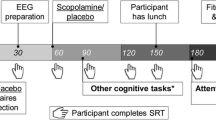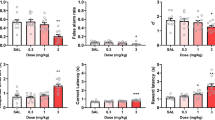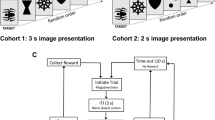Abstract
Central cholinergic and adrenergic pathways support the attentional processes necessary for detecting and reporting temporally unpredictable stimuli. To assess the functional effects of pharmacological manipulations of these pathways, male Long-Evans rats performed a two-choice, discrete-trial signal-detection task in which food was provided for pressing one lever after presentation of a signal (a 300-ms light flash), and for pressing a second lever at the end of a trial lacking a signal. Seven signal intensities were presented during each 1-h session in a pseudo-random order across three 100-trial blocks. After acquisition of a stable performance baseline, the acute effects of chlordiazepoxide (0, 3, 5, 8 mg/kg IP), pilocarpine (0, 1.0, 1.8, 3.0 mg/kg SC), scopolamine 0, 0.030, 0.056, 0.100 mg/kg SC), nicotine (0, 0.08, 0.25, 0.75 mg/kg SC), mecamylamine (0, 1.8, 3.0, 5.6 mg/kg IP), clonidine (0, 0.003, 0.010, 0.030 mg/kg SC), and idazoxan (0, 1, 3, 10 mg/kg SC) were assessed. Five measures of performance were analyzed: response failures; the proportion of “hits” [P(hit): the proportion of correct responses on signal trials]; the proportion of “false alarms” [P(fa): the proportion of incorrect responses on non-signal trials]; and response times (RT) for hits and for correct rejections. All drugs which slowed responding affected RT for hits and correct rejections equivalently, suggesting little or no influence of motor slowing on choice accuracy. Chlordiazepoxide reduced P(hit) at low signal intensities only, without affecting P(fa) or RT, consistent with sensory impairment (reduced visual sensitivity). All other drugs except nicotine reduced P(hit) at high signal intensities preferentially, suggesting a non-visual source of the impairment. Scopolamine, mecamylamine and clonidine affected both P(hit) and P(fa); pilocarpine and idazoxan reduced P(hit) without affecting P(fa). Nicotine at 0.75 mg/kg decreased P(hit) in the first block of trials; at 0.08 mg/kg it increased P(hit) in the second block; no dose affected P(fa). RTs were increased by pilocarpine, scopolamine, mecamylamine and clonidine, but not by nicotine or idazoxan. The data suggest that drugs which reduce cholinergic or adrenergic tone (scopolamine, mecamylamine and clonidine) impair sustained attention by decreasing the detection of signals and by increasing the false alarm rate, whereas drugs which elevate cholinergic or adrenergic tone (pilocarpine, nicotine and idazoxan) decrease attention by impairing detection of signals without affecting the false alarm rate. In contrast, the GABA-facilitating drug chlordiazepoxide appeared to affect visual thresholds rather than attention.
Similar content being viewed by others
Author information
Authors and Affiliations
Additional information
Received: 16 October 1996 /Final version: 16 May 1997
Rights and permissions
About this article
Cite this article
Bushnell, P., Oshiro, W. & Padnos, B. Detection of visual signals by rats: effects of chlordiazepoxide and cholinergic and adrenergic drugs on sustained attention. Psychopharmacology 134, 230–241 (1997). https://doi.org/10.1007/s002130050446
Issue Date:
DOI: https://doi.org/10.1007/s002130050446




